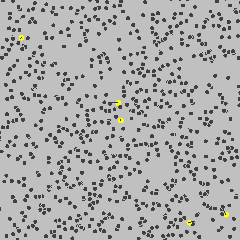Contents
Key Stage 3
Meaning
Brownian Motion is the seemingly random movement of very small, visible, particles when viewed under a microscope.
About Brownian Motion
- Brownian Motion is evidence of the particle model of matter.
- When viewed under a microscope small objects like a pollen grain or tea leaf seem to change direction randomly.
- Brownian Motion can be explained if the small objects are being hit by other, even smaller objects that cannot be seen. This is evidence that matter is made of particles.
|
In this animation the grey particles represent particles too small to see. The yellow particles represent particles that are big enough to see and the blue lines show the random path of the yellow particles. |
Key Stage 4
Meaning
Brownian Motion is the seemingly random movement of very small, visible, particles when viewed under a microscope.
About Brownian Motion
- Brownian Motion is evidence of the particle model of matter.
- When viewed under a microscope small objects like a pollen grain or tea leaf seem to change direction randomly.
- Brownian Motion can be explained if the small objects are being hit by other, even smaller objects that cannot be seen. This is evidence that matter is made of particles.
|
In this animation the grey particles represent particles too small to see. The yellow particles represent particles that are big enough to see and the blue lines show the random path of the yellow particles. |
References
AQA
Key Stage 5
Meaning
Brownian motion is the random and unpredictable motion of a particle caused by collisions with molecules of the surrounding substance.
About Brownian Motion
- Brownian motion demonstrates the kinetic theory of matter.
- Brownian motion is observed in particles suspended in a fluid.
- Brownian motion provided early evidence for the existence of atoms and molecules.
- Brownian motion is described mathematically by the Einstein relation for diffusion.
Examples
- The random movement of pollen grains in water observed under a microscope.
- Used in determining Avogadro's number by observing particle movement in a fluid.
